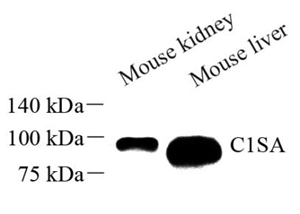| Reactivity: | M |
| Applications: | WB |
| Host Species: | Rabbit |
| Clonality: | Polyclonal |
| Full Name: | C1s rabbit polyclonal antibody |
Gene Name: | Complement C1s-A subcomponent |
Synonyms: | C1 esterase, Complement component 1 subcomponent s-A, C1sa, C1s |
Immunogen: | Recombinant protein corresponding to Mouse C1s |
Isotype: | IgG |
Purity: | Affinity purification |
Predicted MW. | 77 kDa |
Observed MW. | 80 kDa |
Uniprot ID: | Q8CG14 |
Product Usage Information
Applications | Species | Dilution | Positive Sample |
WB | Mouse | 1: 500-1: 1000 | kidney, liver |
Background
The complement component proteins, C1, C3, C4, and C5, are potent anaphylatoxins that are released during complement activation. Binding of these proteins to their respective G protein-coupled receptors induces proinflammatory events, such as cellular degranulation, smooth muscle contraction, arachidonic acid metabolism, cytokine release, leukocyte activation, and cellular chemotaxis. C1q, together with proenzymes C1r and C1s, yield C1, the first component of the classical pathway of the serum complement system. C1 consists of a calcium dependent trimolecular complex of C1r, C1s and C1q. Activated C1s is in the form of a disulfide-linked heterodimer consisting of a heavy chain and a light chain. Defects in the gene encoding for C1s can cause selective C1s deficiency, a disorder characterized by early onset of various autoimmune diseases.
Images
|
|
Western blot analysis of C1SA (GB111405) at dilution of 1: 500 |
Storage
| Storage | Store at -20°C for one year. Avoid repeated freeze/thaw cycles. |
| Storage Buffer | PBS with 0.02%sodium azide,100 μg/ml BSA and 50% glycerol. |




